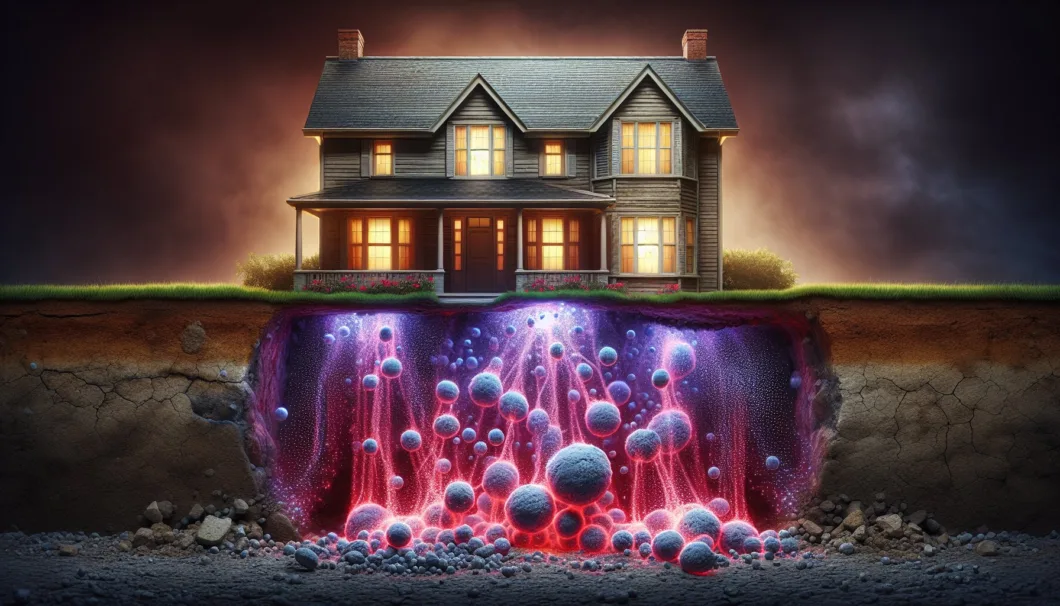The Invisible Threat of Radon Gas in Homes
Radon gas, a naturally occurring radioactive substance, is an invisible and silent threat that could be lurking in any of our homes. This odorless and colorless gas is produced deep down in the ground, when uranium, thorium, and radium break down in soil, rock, and water. It makes its way into homes, seeping through cracks in the foundation, construction joints, gaps in foundations, or openings near pipes or wires, as it gets squeezed out of the earth towards the open air and disperses in the atmosphere. It can also enter your home through well water.
Long-term exposure to high levels of radon can pose serious health risks, although it’s not the gas itself that is the danger, it’s its “daughters,” alpha-particles, which are solid. When inhaled, radon’s radioactive decay products, because they are in solid form, can get trapped in your lungs. Over time, these radioactive materials can damage lung tissue and increase the risk of lung cancer. It’s estimated that radon exposure is the second leading cause of lung cancer, after cigarette smoking, causing about 20,000 deaths in the United States each year. Smoking in itself massively enhances the dangers as the two interact in an extremely dangerous way, elevating the risk tremendously.
Despite these alarming statistics, many homeowners remain unaware of the dangers of radon gas. This is largely because radon is difficult to detect without specialized equipment. The only way to know if your home has high levels of radon is to test for it. Test kits are available at most hardware stores and are relatively inexpensive and easy to use. For accurate results, it’s important to follow package instructions carefully.
However, only professional grade instruments and professional radon measurement technicians can carry out tests that are reliable in accuracy. Whether it’s instant, short, medium, or long term tests, the level of technology involved is critical for deciding on action and meets the standards required in real estate transactions.
The shorter the duration of the test for radon, the less actionable are the results, as the levels can vary immensely throughout the seasons and even over a day. So long term readings are the best ones to get an actionable idea about the real levels of radon gas in a home.
Radon exposure can occur in any type of home, whether it has a basement, a crawl space, or is built on a slab. However, radon levels are usually higher in places that are closer to the ground, such as basements or underground mines. Homes near soil that contains more radioactive metal, that are poorly ventilated, very tightly sealed, or very well-insulated are also at higher risk. The U.S. Environmental Protection Agency (EPA) estimates that elevated radon levels are present in one of every 15 American homes.
If testing for radon reveals high levels of radioactive particles in your home, don’t panic. There are ways to reduce radon levels. These include sealing cracks in floors and walls, increasing ventilation, and in some cases, installing a radon reduction system. A professional radon contractor can help you choose the best method for your home.
Following the installation of a radon mitigation system, as recommended, a continuous radon monitoring system should also be installed, as levels may change over time, radon mitigation may be adjusted to further regulate new levels, and mitigation systems may fail suddenly and go unnoticed.
In conclusion, radon gas is a silent and invisible threat that could be lurking in our homes. It’s crucial to test for radon and take necessary steps to reduce its levels if they’re too high. By doing so, we can protect ourselves and our loved ones from the dangers of this radioactive gas. Remember, the risk posed by radon gas is preventable. Let’s take action today for a healthier tomorrow.





Pingback: Radon Gas could be in your home as well! - Proxima Bulletin: News, Info & Updates